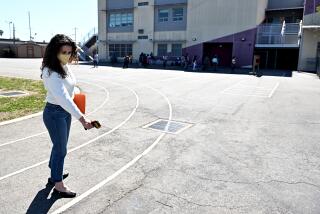School Outlook for 2000: Gloomy : Two-Year Study Predicting a Shortage of $146.9 Million
The San Diego city school system will fall just $3.3 million short of funding its massive, $141.8 million need for new school construction between 1986 and the turn of the century, according to a two-year study of the district’s future growth released Friday.
But maintenance costs for the San Diego Unified School District’s aging buildings will present a more formidable problem: costs during the next 14 years will total $199.6 million, but funding is projected at just $56 million, the study shows.
The figures, contained in the long-awaited Long Range Facilities Master Plan that will govern district building and renovation efforts for the rest of the century, offer a slightly more optimistic look at the future than a preliminary version of the report released Dec. 31.
In the earlier document, planners estimated their coffers would be $15 million short of the amount needed to build new schools for the estimated 45,000 new students who will swell enrollment to 160,000 by the year 2000. They also estimated that the school system would be $161 million short of its overall needs, including maintenance.
The revised version released Friday shows a total deficit of $146.9 million.
In either case, the district will face a huge cash shortage unless new revenue can be found, said Dean Nafziger, head of the district’s planning, research and evaluation department.
“Our district keeps getting older and older, so we have all kinds of major maintenance” costs, said Charles Johnson, director of facilities services for the school system. “By the year 2000, 75% of the district’s buildings will be 30 years old.”
The best hope for new revenue is still the district’s attempts to offer long-term leases of closed school sites to developers, known as its “property management program.” The effort is on hold until at least March 9, when the City Council is scheduled to review both a school board proposal that would allow the plan to move ahead and zoning regulations that would hinder it.
The new study, which reflects the work of three 11-member community panels that studied the school district’s three geographical regions, outlines other possible sources of revenue from the state and federal government. But it recommends that the district not participate in the state’s new $800-million school construction program because the rules of that initiative could actually cost the district more money than it receives.
“Right now, we think there are more disadvantages than advantages to getting involved,” Nafziger said.
The enrollment boom will be most rapid in elementary schools during the rest of this decade and will swell high school enrollments between 1990 and 1995, the report predicts. Currently, it costs the district $5 million to build an elementary school, more than $11 million to build a junior high school, and more than $20 million to build a high school. The prices do not include land acquisition costs.
By the end of the century, the district will build a high school in Scripps Ranch; a junior high school in the west Mira Mesa area; a school for children in grades 4-12 in Bay Terraces; two elementary schools in Mira Mesa; and a new elementary school in East San Diego. Four mid-city elementary schools--Adams, Central, Edison and Euclid--would be reconstructed.
Starting in September, ninth-graders at Mira Mesa High School would be moved to Wangenheim Junior High School. Wangenheim’s seventh-graders would be moved to a school composed entirely of portable buildings for two years. By the fall of 1989, they would be able to attend the newly built junior high school.
The plan also forecasts heavy reliance on multitrack year-round school schedules, with 36 schools slated for involvement in the atypical schedules between 1988-89 and 2000. Another, Jerabek elementary in Scripps Ranch, would adopt the schedule in July.
Also slated is adoption of a double-session kindergarten schedule in virtually every school that is not a magnet school or a “minority isolated” school (schools designated as unbalanced between minority and white students).
Other possible ways to handle enrollment growth are the purchase of more portable classrooms, reopening certain closed school sites, staggering the starting times of secondary schools and switching to a seven-period school day. Busing students to less-crowded schools and placing entire schools on a double-session schedule were two solutions rejected by planners.
The report will be presented to school trustees Tuesday. Two public hearings will be held before they vote on its contents Feb. 10.
More to Read
Sign up for Essential California
The most important California stories and recommendations in your inbox every morning.
You may occasionally receive promotional content from the Los Angeles Times.










